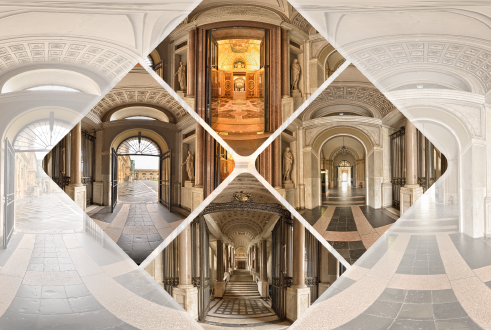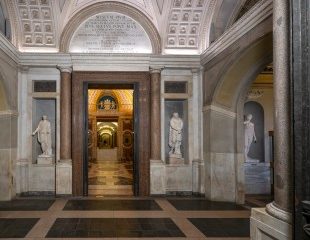
The Atrium of the Four Gates
Reflections on the restoration of the sculptures
Vatican Museums Conference Hall – in person and live streaming
On 25 September the Vatican Museums will dedicate an event as part of the Thursdays in the Museums series to the restoration of the ancient sculptures on display in the Atrium of the Four Gates. Between 2023 and 2024, a complex conservation work was carried out on a group of works consisting of twelve statues and two decorated relief sarcophagi. All the artefacts, dating from the Roman era between the first and second centuries AD, mainly depict male subjects - athletes and heroes - alongside toga-clad figures from the funerary sphere, whose provenance remains uncertain.
The Atrium of the Four Gates, an imposing structure with a floor plan in the shape of a Greek cross, surmounted by a large dome, was designed in 1786 by the architect Giuseppe Camporese. Overlooking the gardens, between 1870 and 1932 it served as the entrance to the Vatican Museums. The perimeter niches house eight sculptures; four others are in the vestibule at the base of the Simonetti Staircase, together with two sarcophagi (1776-1784).
The currently visible works are the result of additions, alterations and adaptations that have combined original portions with modern completions, often in different marbles. One of the most representative examples is the statue of Meleager, a pastiche by the sculptor Vincenzo Pacetti, combining a torso of in the tradition of Polykleitos with a head of the god Ares and the addition of a wild boar’s snout. Of particular interest are the portraits of the emperors Claudius and Titus, inserted to complete a torso inspired by an iconographic model from the fifth century BC, and a statue, a replica of Polykleitos' Doryphoros, respectively.
The variety of conservation conditions and the critical issues identified required targeted intervention, carried out by the Kavaklik Restoration Consortium under the scientific direction of the Department of Greek and Roman Antiquities and the Stone Materials Restoration Laboratory, with the collaboration of the Cabinet of Scientific Research and the support of the Patrons of the Arts in the Vatican Museums, Florida Chapter.
Careful cleaning of the surfaces enabled the history of the numerous restorations carried out over time to be reconstructed, also bringing to light unexpected discoveries. The great variety of the preceding interventions, often characterized by the widespread use of plaster, has made a flexible approach necessary, adapted to the specifics of each item.
The meeting will be chaired by Barbara Jatta, Director of the Vatican Museums, with Giandomenico Spinola, artistic-scientific Deputy Director, and Msgr. Terence Hogan, Coordinator of the Office of the Patrons of the Arts. Claudia Valeri, Curator of the Department of Greek and Roman Antiquities, will also speak, with a reflection on the antiquarian interpretation of classical iconography. Eleonora Ferrazza and Clara di Fazio, Assistants in the same Department, will present the latest findings from documentary research and observations on the architectural design of the Atrium. Guy Devreux, Maestro in charge of the Stone Materials Restoration Laboratory, and Kristian Schneider, restorer at the Kavaklik Consortium, will illustrate the techniques used and the various stages of the work.
The meeting will be followed by a guided tour of the Atrium of the Four Gates, to admire the renewed appearance of the Roman sculptures.

















